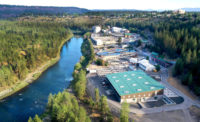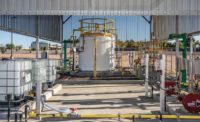Chandler, Ariz.
Key Players
Owner/Developer City of Chandler
Lead Design Firm Wilson Engineers
General Contractor McCarthy Building Cos.
Structural Engineering Nabar Stanley Brown
Civil Engineering Southwest Land Consulting
MEP Engineering Wilson Engineers
Electrical Instrumentation and Controls Carollo Engineers
The $105.5-million wastewater treatment expansion project for the city of Chandler increased capacity at the facility to 22 million gallons per day from 15 million.
Initially planned as a five concurrent critical path item schedule, the project team, led by general contractor McCarthy Building Cos., used pull-planning sessions, short-term structure reviews and a procurement and delivery matrix to achieve a single critical path schedule to most adequately prepare an efficient construction schedule. The entire construction team, including subcontractors and the owner, met quarterly to review progress and strategy.
“Through proactive measures, hard work, determination and complete project buy-in, the team successfully managed to work the schedule down to a single critical path and turn the project over to the client right on schedule,” says Daniel Ward, McCarthy’s project manager.
Construction started in June 2012 and was completed in September 2014.
Another element driving the schedule was outside water restrictions from a private industrial company that required an operational and re-permitted project within 24 months. The project team implemented a construction manager at-risk delivery method and created five separate guaranteed maximum price design packages to begin construction and procurement early to successfully reach the completion date.
“The design and construction overlapped one another by over 11 months, forcing the team to unite and collaborate during both key components to the project,” Ward says.
The project team utilized virtual design and construction to detect potential clashes prior to field installation, with updates released in real time and used to coordinate quality installations, punch lists, start-up and testing.
Working on an active site presented challenges with buried utilities. Several of the new structures required engineered shoring plans that used soil nails and shotcrete walls to ensure no interruption of existing underground utilities.
Excavation for the Reclaimed Water Pump Station was nearly 45 ft deep, which required beam-and-lagging style shoring and tying cross braces into the shotcrete every 15 ft. During excavation, crews suspended a live-power source and an active reclaimed water distribution line.
According to McCarthy, the project tested the skills of its water team more than any previous project. McCarthy self-performed concrete, rough carpentry, metals, process mechanical, process equipment, plumbing and HVAC over more than 250,000 hours. The firm credits the self-performing work for saving the client more than $1.8 million.
In May 2014, the project received safety recognition as a Voluntary Protection Program STAR site from the Arizona Division of Occupational Safety and Health. The OSHA recordable incident rate was 0.77 with more than 500,000 hours worked.












